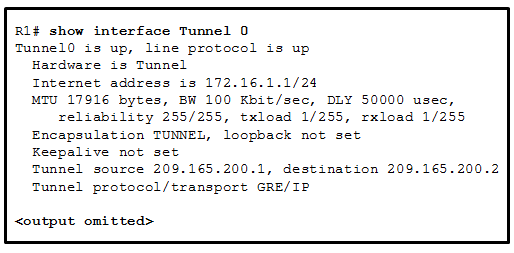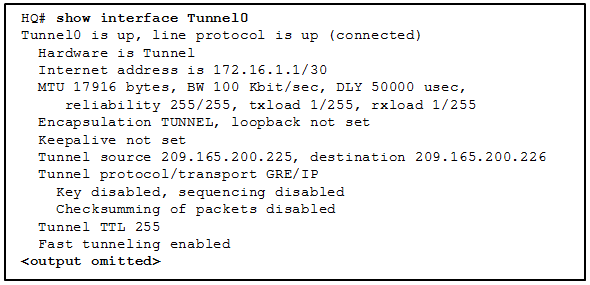Last Updated on May 3, 2018 by Admin
CCNA 4 Chapter 7
From year to year, Cisco has updated many versions with difference questions. The latest version is version 6.0 in 2018. What is your version? It depends on your instructor creating your class. We recommend you to go thought all version if you are not clear. While you take online test with netacad.com, You may get random questions from all version. Each version have 1 to 10 different questions or more. After you review all questions, You should practice with our online test system by go to "Online Test" link below.
| Version 5.02 | Version 5.03 | Version 6.0 | Online Assessment |
| Chapter 7 Exam | Chapter 7 Exam | Chapter 7 Exam | Online Test |
| Next Chapter | |||
| Chapter 8 Exam | Chapter 8 Exam | Chapter 8 Exam | Online Test |
| CCNA 4 Lab Activities | |||
| NA | |||
-
A network design engineer is planning the implementation of a cost-effective method to interconnect multiple networks securely over the Internet. Which type of technology is required?
- a GRE IP tunnel
- a leased line
- a VPN gateway
- a dedicated ISP
-
What is one benefit of using VPNs for remote access?
- lower protocol overhead
- ease of troubleshooting
- potential for reduced connectivity costs
- increased quality of service
-
How is “tunneling” accomplished in a VPN?
- New headers from one or more VPN protocols encapsulate the original packets.
- All packets between two hosts are assigned to a single physical medium to ensure that the packets are kept private.
- Packets are disguised to look like other types of traffic so that they will be ignored by potential attackers.
- A dedicated circuit is established between the source and destination devices for the duration of the connection.
-
Two corporations have just completed a merger. The network engineer has been asked to connect the two corporate networks without the expense of leased lines. Which solution would be the most cost effective method of providing a proper and secure connection between the two corporate networks?
- Cisco AnyConnect Secure Mobility Client with SSL
- Cisco Secure Mobility Clientless SSL VPN
- Frame Relay
- remote access VPN using IPsec
- site-to-site VPN
-
Which two scenarios are examples of remote access VPNs? (Choose two.)
- A toy manufacturer has a permanent VPN connection to one of its parts suppliers.
- All users at a large branch office can access company resources through a single VPN connection.
- A mobile sales agent is connecting to the company network via the Internet connection at a hotel.
- A small branch office with three employees has a Cisco ASA that is used to create a VPN connection to the HQ.
- An employee who is working from home uses VPN client software on a laptop in order to connect to the company network.
-
Which statement describes a feature of site-to-site VPNs?
- The VPN connection is not statically defined.
- VPN client software is installed on each host.
- Internal hosts send normal, unencapsulated packets.
- Individual hosts can enable and disable the VPN connection.
-
What is the purpose of the generic routing encapsulation tunneling protocol?
- to provide packet level encryption of IP traffic between remote sites
- to manage the transportation of IP multicast and multiprotocol traffic between remote sites
- to support basic unencrypted IP tunneling using multivendor routers between remote sites
- to provide fixed flow-control mechanisms with IP tunneling between remote sites
-
Which remote access implementation scenario will support the use of generic routing encapsulation tunneling?
- a mobile user who connects to a router at a central site
- a branch office that connects securely to a central site
- a mobile user who connects to a SOHO site
- a central site that connects to a SOHO site without encryption
-
Refer to the exhibit. A tunnel was implemented between routers R1 and R2. Which two conclusions can be drawn from the R1 command output? (Choose two.)
- This tunnel mode is not the default tunnel interface mode for Cisco IOS software.
- This tunnel mode provides encryption.
- The data that is sent across this tunnel is not secure.
- This tunnel mode does not support IP multicast tunneling.
- A GRE tunnel is being used.
-
Refer to the exhibit. Which IP address would be configured on the tunnel interface of the destination router?
- 172.16.1.1
- 172.16.1.2
- 209.165.200.225
- 209.165.200.226
-
Which statement correctly describes IPsec?
- IPsec works at Layer 3, but can protect traffic from Layer 4 through Layer 7.
- IPsec uses algorithms that were developed specifically for that protocol.
- IPsec implements its own method of authentication.
- IPsec is a Cisco proprietary standard.
-
Which function of IPsec security services allows the receiver to verify that the data was transmitted without being changed or altered in any way?
- anti-replay protection
- authentication
- data integrity
- confidentiality
-
Which statement describes a characteristic of IPsec VPNs?
- IPsec is a framework of Cisco proprietary protocols.
- IPsec can secure traffic at Layers 1 through 3.
- IPsec encryption causes problems with routing.
- IPsec works with all Layer 2 protocols.
-
What is an IPsec protocol that provides data confidentiality and authentication for IP packets?
- AH
- ESP
- RSA
- IKE
-
What two encryption algorithms are used in IPsec VPNs? (Choose two.)
- DH
- PSK
- IKE
- AES
- 3DES
-
Which algorithm is an asymmetrical key cryptosystem?
- RSA
- AES
- 3DES
- DES
-
Which two algorithms use Hash-based Message Authentication Code for message authentication? (Choose two.)
- 3DES
- DES
- AES
- MD5
- SHA
-
Which three statements describe the building blocks that make up the IPsec protocol framework? (Choose three.)
- IPsec uses encryption algorithms and keys to provide secure transfer of data.
- IPsec uses Diffie-Hellman algorithms to encrypt data that is transferred through the VPN.
- IPsec uses 3DES algorithms to provide the highest level of security for data that is transferred through a VPN.
- IPsec uses secret key cryptography to encrypt messages that are sent through a VPN.
- IPsec uses Diffie-Hellman as a hash algorithm to ensure integrity of data that is transmitted through a VPN.
- IPsec uses ESP to provide confidential transfer of data by encrypting IP packets.
-
A network design engineer is planning the implementation of an IPsec VPN. Which hashing algorithm would provide the strongest level of message integrity?
- SHA-1
- MD5
- AES
- 512-bit SHA
-
What is the purpose of utilizing Diffie-Hellman (DH) algorithms as part of the IPsec standard?
- DH algorithms allow unlimited parties to establish a shared public key that is used by encryption and hash algorithms.
- DH algorithms allow two parties to establish a shared secret key that is used by encryption and hash algorithms.
- DH algorithms allow unlimited parties to establish a shared secret key that is used by encryption and hash algorithms.
- DH algorithms allow two parties to establish a shared public key that is used by encryption and hash algorithms.
-
What is the purpose of a message hash in a VPN connection?
- It ensures that the data cannot be read in plain text.
- It ensures that the data has not changed while in transit.
- It ensures that the data is coming from the correct source.
- It ensures that the data cannot be duplicated and replayed to the destination.
-
Which Cisco VPN solution provides limited access to internal network resources by utilizing a Cisco ASA and provides browser-based access only?
- clientless SSL VPN
- client-based SSL VPN
- SSL
- IPsec
-
What key question would help determine whether an organization should use an SSL VPN or an IPsec VPN for the remote access solution of the organization?
- Is a Cisco router used at the destination of the remote access tunnel?
- What applications or network resources do the users need for access?
- Are both encryption and authentication required?
- Do users need to be able to connect without requiring special VPN software?
-
Open the PT Activity. Perform the tasks in the activity instructions and then answer the question.
What problem is preventing the hosts from communicating across the VPN tunnel?
- The EIGRP configuration is incorrect.
- The tunnel IP addresses are incorrect.
- The tunnel source interfaces are incorrect.
- The tunnel destinations addresses are incorrect.
From year to year, Cisco has updated many versions with difference questions. The latest version is version 6.0 in 2018. What is your version? It depends on your instructor creating your class. We recommend you to go thought all version if you are not clear. While you take online test with netacad.com, You may get random questions from all version. Each version have 1 to 10 different questions or more. After you review all questions, You should practice with our online test system by go to "Online Test" link below.
| Version 5.02 | Version 5.03 | Version 6.0 | Online Assessment |
| Chapter 7 Exam | Chapter 7 Exam | Chapter 7 Exam | Online Test |
| Next Chapter | |||
| Chapter 8 Exam | Chapter 8 Exam | Chapter 8 Exam | Online Test |
| CCNA 4 Lab Activities | |||
| NA | |||

